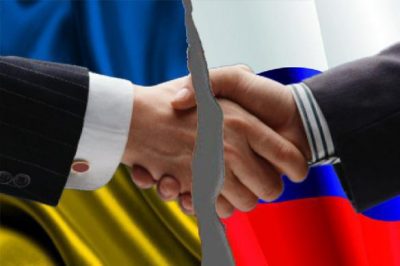The Russia-Ukraine Prisoner Swap: A Path to Peace and Rapprochement?

The Russian-Ukrainian prisoner swap proves that some degree of goodwill exists on both sides towards the other after Zelensky’s historic election and recent clinching of a parliamentary majority, thus making it more likely that they’ll continue down the path of peace and rapprochement with one another and thus advance the spirit of the nascent “New Detente”.
There’s a glimmer of hope that Russia and Ukraine are finally moving towards a rapprochement with one another after their massive prisoner swap over the weekend, which Trump exuberantly described on Twitter as “very good news, perhaps a first giant step to peace”. It’s very likely that the US played a role in events by at the very least approving what its newest European vassal state decided to do, which would explain the President’s enthusiastic praise of this move and strongly suggest that the nascent “New Detente” between the West and Russia is continuing to proceed apace following the groundbreaking success of President Putin’s visit to France late last month. Speaking of that European country, both parties held 2+2 talks between their Defense and Foreign Ministers in Moscow shortly following the swap, after which they agreed that recent events in Ukraine such as that one and the introduction of a ceasefire have established the conditions to hold another Normandy Four summit sometime in the near future perhaps even as soon as this month.
It should be noted that President Putin held a phone call with his Ukrainian counterpart after the swap was completed and that the prospective Normandy Four summit would symbolically represent their first face-to-face meeting. Zelensky’s historic election and recent clinching of a parliamentary majority give him tremendous freedom to make the hard and previously politically impossible decisions needed to bring peace to Donbas, namely agreeing to separate that issue from the Crimean one and accepting the need to fulfill at least some aspect of the Minsk Accords related to bestowing the restive region with a degree of autonomy (even if it ultimately only ends up being transitional). The stage is already set on the Russian side to facilitate this since Moscow never engaged in any formal military intervention in the two separatist republics like it’s been incessantly accused of and which would have in that case made “reintegration” impossible.
Not only that, but Moscow’s decision to extend citizenship to interested citizens in Donbass wasn’t intended to lay the basis for the region’s forthcoming incorporation into the Russian Federation like many observers wrongly assessed at the time, but to provide an “exit strategy” for any civilians who might be concerned about the personal consequences of being reintegrated into a semi-fascist state pending a future deal between Russia and Ukraine to this effect. Seen through this perspective and considering the extensive behind-the-scenes security cooperation between both nations’ services that must have preceded the eventual prisoner swap, it can be concluded that Russia has been preparing for this sort of political breakthrough ever since Zelensky’s election, even if it didn’t seem obvious to most at that time and only until this weekend. Returning back to what was mentioned at the beginning of this analysis, the US likely played a role in events by simply allowing them to proceed and not obstructing them, which is very significant to point out.
Trump, who proudly describes himself as one of the world’s best dealmakers, understands International Relations in a mostly transactional sense where every agreement involves some kind of quid pro quo. In this instance, the US’ surprisingly supportive stance in Ukraine is probably due to Russia’s “flexibility” in Syria whereby Moscow “passively facilitates” their joint “Israeli” ally‘s anti-Iranian bombing operations. These have been extremely effective in stemming the spread of Iranian influence in the war-torn country and ensuring the security of the self-professed “Jewish State”, so it naturally follows that it’s in the US’ “balance of power” interest to see Russian influence replace Iran’s there in the long-term seeing as how both Washington and Moscow are committed to defending Tel Aviv whereas Tehran wants to destroy it. It’s this dynamic that’s probably the most responsible for the US’ changed attitude towards Ukraine, with both of these theaters of strategic competition being among the most important for shaping the course of the “New Detente”.
The state of Russian-Western affairs is therefore much better behind the scenes than is publicly recognized, though there’s nevertheless no downplaying the seriousness of their strategic arms competition. Still, the overall momentum is very positive and suggests that a “balance” is being reached for more effectively managing their relations, with the recent progress being made in Ukraine strongly suggesting that it might eventually be possible to lift the anti-Russian sanctions and therefore officially “normalize” ties in the coming future. That’s still a bit of a way’s off from happening though, but it can’t be denied that a lot of work has already been done to make that happen when remembering that Russia is about to return to the Council of Europe, Russian-French relations are once again on the upswing, and the tacit Russian-American coordination in Syria for ensuring “Israel’s” security might have been responsible for the successful Ukrainian prisoner swap. All told, while there are still reasons to be cautious, recent events do inspire optimism for the “New Detente”.
*
Note to readers: please click the share buttons above or below. Forward this article to your email lists. Crosspost on your blog site, internet forums. etc.
This article was originally published on OneWorld.
Andrew Korybko is an American Moscow-based political analyst specializing in the relationship between the US strategy in Afro-Eurasia, China’s One Belt One Road global vision of New Silk Road connectivity, and Hybrid Warfare. He is a frequent contributor to Global Research.
Featured image is from PravdraReport

